From The CRPG Addict
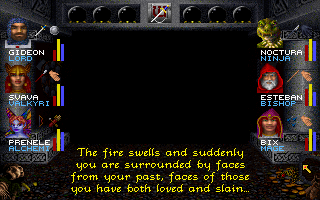 |
| I would hope that the number of people I have “both loved and slain” is small. |
In several long sessions, I conquered and pillaged the Temple of Munkharama. I had to review my screenshots from hours ago to remember why I was there in the first place. (Because of all the dialogue and descriptions, my screenshots folder has swiftly ballooned to over 2,000 shots.) It goes back to the garrulous Brother T’Shober, guardian of the Munkharama Bridge, who begged me to find my way to the Temple, beneath the city above it, and retrieve the Holy Work before a bunch of evil monks from the Dark Forest got to it first. He told me to bring it to Master Xheng, Lord of the 5 Flowers.
I thought the Holy Work might be the Astral Dominae, but I should have realized it was silly to expect any actual connection between the game and its backstory this soon, if at all. Instead, it was just a book.
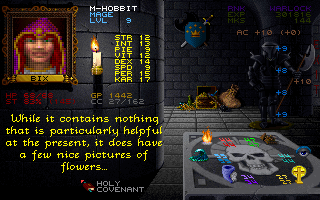 |
| A book as helpful as the in-game text! |
Reaching it was a long process that began by–as I had surmised several entries ago–shouting “COINS” as a response to the riddle of the well. In return, it delivered me four coins that I had to use in four receptacles to open four doors, two of which had switches that opened secret doors accessible from the other two. One of those secret areas led to a bunch of new rooms on the east side of the monastery, one to a bunch of rooms on the west.
The east side housed a logic puzzle by which I had to drop four beans into four chalices and then pull a spindle in a central room. The spindle activated a kind of slot machine with four panels colored black or white. It took me a few tries to figure out what was going on, but basically after pulling the spindle, the panels showed me how many beans were in the correct chalices by the number of black panels vs. white panels–but not which beans were correct. Every time I got it wrong, I got dumped through a trap door into a basement and took damage. There were 4!=24 potential combinations, but each try gave me enough information to cross several possibilities off the list and narrow it down. Eventually, I got it right. The solution opened a secret door to the rest of the section.
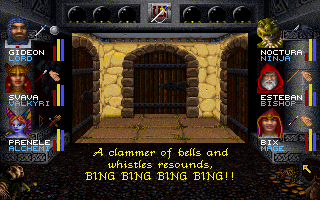 |
| This was a good thing. |
With my recent failure in Shadowlands on my mind, I should point out that this is the kind of puzzle I like. It takes some effort and experimentation to figure out what’s happening, and once you intuit that, you can solve it by logic. It wasn’t just about mechanics, and there weren’t rats or a food meter impelling me to solve it faster.
The new passage led the party to Brother Moser’s Apothecary. Aside from selling potions, he didn’t have a lot that was interesting to offer just yet.
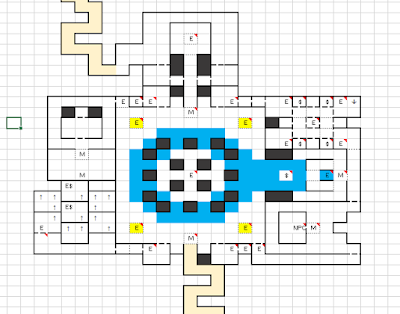 |
| My full map of Munkharama. |
Over on the west side, I found myself in front of a large building labeled “Palace of the Gran Melange, The Land of Dreams.” (“Gran Melange” is a perfect David Bradley phrase, like “Dark Savant,” that at first sounds okay but then falls apart when you consider its true meaning, in this case something like “great miscellany.”) Inside, a monk wanted to know what I was doing there. I tried HOLY WORK, GRAN MELANGE, ASTRAL DOMINAE, and even COSMIC FORGE (hey, my characters are still a bit confused) before finding success with (duh) DREAMS. But I couldn’t answer his second question about “what happens to those who cannot walk the land of dreams” until I returned to Brother Moser and asked him, and learned that such people “walk the land of the living dead.” This is another kind of puzzle that I like: the kind where you have to pay attention and take notes, then use those notes at a later point. Admittedly, the copious verbiage in this game makes it tough.
What followed were a series of rooms (connected by a maze of ladders) where I encountered a bunch of monks high on some kind of pipeweed, spouting nonsense about life being a dream and other silliness that was probably meant to sound profound. (Sample: “Life is a mystery, a puzzle, a riddle, a rebus, an enigma. As you live, you discover some of its pieces. Some you know, as if you had always known. Others you do not recognize, and discard. But all is part of the puzzle.”) From these encounters, I got a smoking pipe and some “pastilles” to pack into it.
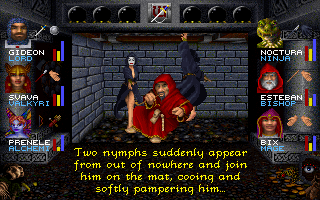 |
| I’ll smoke what he’s smoking. |
The monk at the entrance had warned me not to go through a black door, but it was the only way to go, and after doing so, I found myself in a blank void. And here I got one of the games absurdly, almost offensively long expositions. I’ve complained about wordiness a few times, but I want to make it clear that I certainly don’t mind the brief atmospheric descriptions. For instance, here’s one that came later in the area:
You step into the arena of a tremendous cathedral, its bizarre frescoes long faded, its papal pews submerged under a dense cesspool of stagnant water and filled with the wrenching odor of offal and decay. Thick molds cover much of the ceiling and chamber, and splotches of scummy mires are visible floating on the surface of the water. It is not a very pleasant atmosphere.
Now that’s great. It gives a lot of context to otherwise somewhat featureless wall textures, and it even makes sense given the overall backstory of the location. I wouldn’t mind if the text was delivered a bit faster, in a smaller font, without requiring me to acknowledge every sentence, but I otherwise have no problem with the prose.
Occasionally, the descriptions are funny. I don’t often appreciate Bradley’s humor, but this passage from later (beneath the temple), got a chuckle, even though it hijacked my characters’ attitudes, something I usually object to:
You pull the lever but nothing happens . . . Playing with the lever for a while and getting nowhere, you eventually resort to more forceful tactics. Pretty soon the floor is littered with piece of hacked lever parts, everybody is yelling at everybody else, and finally you concede that some things were not meant to be.
This, on the other hand, is what I got in the dream void:
You step into oblivion. You are falling . . . falling . . . falling. And then you are falling no longer. All is quiet and black. Though you can feel a solid surface beneath your feet, you see nothing, and all around you presses the deep void. A vision of burning flames appears in the distance. You draw closer to the fiery blaze, and you see there is something burning in the flames. It is you. The fire swells and suddenly you are surrounded by faces from your past, faces of those you have both loved and slain. Their skin bubbles and their eyeballs swell and then explode as they scream. And you watch as they turn into a host of blackened charred corpses. Their screams become a mad cackling, and as they crumble into dust you see arise within the flames huge buildings and structures. And you sense that the structures mean something important, but watch as they too crack and fall into the burning inferno. The flame congeals into a flaming ball, and from its smoke and ash forms a sphere of spinning firmament which begins to orbit around the burning mother. And you look upon the sphere as its surface transforms, blossoming an infinite variety of features, and soon there are other spheres and then behind them still others and then a thousand suns dot the black sky. A million planets swarm past you, racing through the void, and time itself seems to accelerate as you witness the birth and demise of nations and whole worlds. You gaze upon the evolution of life as it streams through the galaxies, birthing and growing, warring and dying, and soon the shapes become a blur until they finally collide in a tremendous explosion and time itself becomes exhausted and collapses. And then all is still and black again.
If even that doesn’t seem so bad, keep in mind that this narrative is being delivered basically one sentence at a time, frequently appearing that it’s over, because it ends one-third of the way down the screen, only to start up again on the next screen. And if it still sounds cool, ask yourself: What is the point? Why these images? Do they actually mean anything? Is there any payoff? Maybe I’m wrong, but I don’t think so. I think the author is just being self-indulgent. I think he’s read things like this in other stories, better stories, where there is a purpose and payoff, and he’s trying to mimic that.
Here, it’s just a waste of time. It doesn’t even lead you to the correct next action, which is to combine the pipe and pastilles and light it. A good narrative, in addition to being much shorter, might have ended by saying something like, “You see images in the void, but your sober mind is not in any position to decipher them.” Oh, incidentally, if you do the wrong thing, you have to read all of this again.
Lighting the pipe didn’t make anything more sensible. A being called the Spirit of Life appeared, spouted some more pretentious nonsense (“this is the seed that is the root and heart of all living things” offered a particularly glorious mix of metaphors) and then asked me to choose the form of divine assistance: a sword, a staff, a gown, a ring, or a stone. I somewhat unimaginatively chose the sword, and I was given a magic weapon called the Sword of 4 Winds. Equipped by my lord, it does about twice the damage as his previous sword, so it wasn’t a terrible choice, but I’m curious what the other choices would have gotten me.
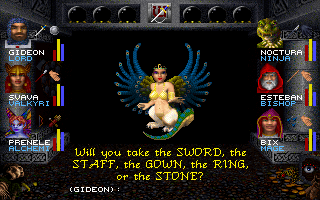 |
| Yeah, choosing the sword is pretty “basic,” but who says “gown” at a time like this? |
Incidentally, I think there’s a bug attached to the sword. First, it’s cursed, which means I can’t unequip it until I cast “Remove Curse.” That’s fine; I don’t want to unequip it. But it’s also one of those weird Wizardry weapons that asks me if I want to “invoke” it, which usually gives you something like an attribute boost in exchange for the item disappearing. In this case, invoking it raises my maximum hit points, permanently, but the sword doesn’t disappear because (I think) of the curse. This means I could theoretically use it to elevate my lord’s hit points to game-breaking heights. But after I saw what was happening (after invoking it twice), I stopped.
Out of the dream world, I found myself in a new area: the courtyard of the Xen Xheng School of 5 Flowers. Inside, Maser Xheng challenged me with a code phrase (“Slay not he that cannot hear”), to which I fortunately knew the counter-phrase from Brother T’Shober: BE THANKFUL YE THAT HATH AN EAR. Master Xheng wanted the Holy Work, which I didn’t have yet, so there wasn’t much else to do here.
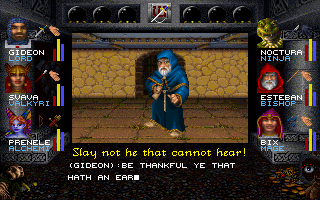 |
| Be thankful ye that took screenshots. |
To get into the temple beneath the city, I had to solve another coin-related puzzle by putting four coins (ruby, emerald, diamond, and amber, found in pools in the central part of the keep) in associated urns: cuprum, viridian, silver, and gold. If it’s not clear (and it wasn’t to me at first), each gem/urn pair is the one closest together in color. This requires you to know that “viridian” is blue-green and that “cuprum” is the Latin word for “copper.”
The underground had two large levels with many interrelated stairways, ladders, and pits. Getting through it was a long process of finding the right keys and objects to open the right doors in other areas. There weren’t a lot of puzzles otherwise, just fairly tough encounters with a variety of monsters. Several types of monks (spelled “munks” by the game for some reason), all with mid-level magic powers, kept attacking. There were also ghosts capable of causing a “terror” effect, nymphs who could cast high-level mass-damage spells, and some kind of floating jellyfish. I hate the “fear” effect, because in addition to taking the party member out of commission (about 50% of the time), there’s a chance that the party member decides on his or her own to flee, abruptly ending combat no matter how well you’re doing.
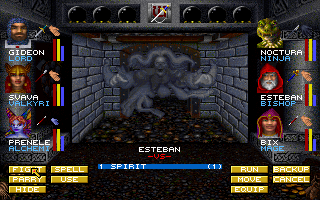 |
| The spirits are particularly well drawn. |
There were three notable “boss” battles. The first involved a bunch of deranged monks and a “leper giant,” who was capable of doing enough damage in a single round to kill a character. Fortunately, he usually missed, but after three tries I couldn’t win the battle without losing one character, so I sucked it up and resurrected her with a scroll I had found earlier.
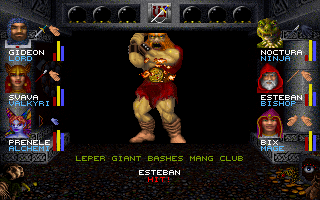 |
| And Esteban goes spinning through the sky. |
The second boss battle was with the leader of the evil monks, the Lord of the Dark Forest, who had some very high level spells and resisted most of mine. I got lucky with a critical hit on my third combat with him.
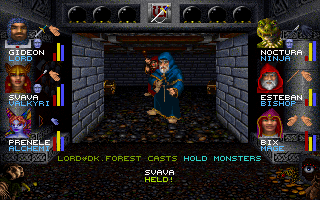 |
| The Lord of the Dark Forest “holds” a bunch of us during our first fight against him. |
The last tough fight was with eight “skeleton lords” in three groups of two. They were curiously resistant to even my highest level “dispel undead” and had to be killed by more conventional means, which was tough because in addition to fear, they can cast “Fireball.” This one combat produced over 17,000 experience points, the highest total in the game so far.
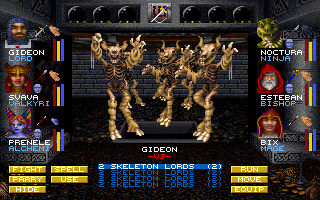 |
| Skeleton lords appear t be skeletons of cows. |
Mitigating the difficulty was a fountain that restored health, stamina, and magic points. It’s been a while since I found one of those. Even with copious resting, the party is so rarely at maximum strength in all three attributes that these fountains really are a cause for celebration. Even better, it was in the middle of a water area, so I used the occasion to swim around (refreshing stamina at the fountain every few moves) until everyone’s “Swimming” skill was at 100. This is enough to swim about six squares before someone dies.
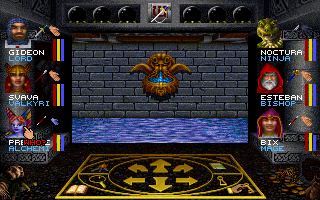 |
| This is always a welcome sight. |
When I was done, I had two artifacts: the Holy Work and something called Wikum’s Globe of Power. I don’t know what the latter object is for, but the former I returned to Master Xheng. He took it gratefully and offered us the choice to join the monastery and learn the “path of the five flowers.” I said sure–I probably just made some irrecoverable faction choice or something–and he gave me a further quest to go find five flowers in some mountains. He also gave me some equipment, which included some cool bits of armor for my ninja.
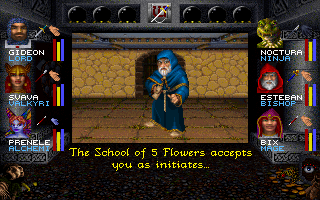 |
| My undiscriminating party just joins the first faction that asks. |
By this time, I should mention, my inventory was bursting with stuff, including a lot of scrolls, potions, bombs, and powders that basically just serve as lesser alternatives to spells. I ended up selling a lot of them to Master Xheng just to clear space.
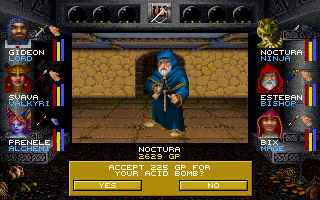 |
| On the one hand, that’s a useful item. On the other, that’s a reasonable amount of money. |
But I still have a bunch of things that I’m not sure about. These include:
- Items marked with large yellow question marks (instead of small white ones) always seem to be quest items. I’ve used most of them (like the cable trolley) and know what they’re for, but I’m still toting around “bone combs and brushes,” a bonsai tree, and a white rubber bear. They’re all mysteries.
- I’ve had two iron keys and a pewter key for a long time, since like maybe the first dungeon.
- Back in the Gorn castle, I fond three jars of “munk innards” and 15 units of “salted munkmeat.” Since munks are humans, the Gorn must be cannibals. Why am I carrying these around?
- A potion called a “Cask of Ill Repute.” I forgot where I got it.
- Something called a “Rebus Egge.” No idea.
- Several items in small blue pouches with stars on them: brimstone nuggets, skullbones, aromatic salts, and deadman’s hair. They sound like spell reagents, but this game doesn’t have a reagent system. Nothing happens when I try to “use” or “merge” these.
During these explorations, I kept encountering certain NPCs over and over. It got a little annoying because they almost all have several screens of inescapable text before you can talk to them or dismiss them. One of them was the Gorn king, who I’d met in his castle. He alternately told me that the war was going well or poorly, sometimes both within a matter of 10 steps. Brother T’Shober appeared once, but I didn’t get anything useful from him. An Umpani named Lt. Gruntrapper stopped us a couple of times. When I went to trade with him (which I almost always try with NPCs), I saw that he was carrying something called a “Crypt Map.” I got an idea from comments that I’m supposed to be collecting these “maps,” so I bought it from him, even though it took 2/3 of my gold. Finally, some tall blue guy from the “priests of Dane” kept ranting about the end of the world, but I could never get him to like us enough to talk or trade.
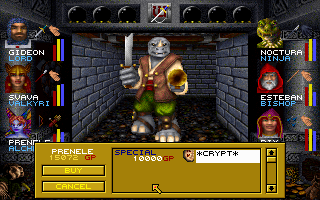 |
| This had better pay off. |
Leveling slowed to a crawl, causing a bit of a withdrawal after my last session. Almost everyone is back up to Level 10 in their primary classes, and with hundreds of thousands of experience points necessary to get to Level 11, it’s hard to imagine ever making it to, say, Level 15. I don’t think I’ll be up for yet another round of class-changing, though, so I’ll just see how it goes.
I have no particular idea where to go next. A couple of my characters have the “Watchbells” spell now (which awakens sleeping party members), so I could try that field of poppies, and there are some water squares I could explore given my new ability to swim. Beyond that, there are unexplored paths to the south of Munkharama and to the north of Orkogre Castle.
This session ended at the 40-hour mark, and I feel like at this point I should have some sense of the main plot, but if it wasn’t for the Umpani and T’Rang showing up occasionally, I’d begin to suspect that the backstory has nothing to do with the game itself. I may feel differently by the end, but right now, it feels I’m in the middle of a sprawling, silly narrative with little thematic consistency or sensible story arc. At least I like the combat, leveling, exploration, mapping, and puzzles.
Time so far: 40 hours
Original URL: http://crpgaddict.blogspot.com/2018/10/crusaders-of-dark-savant-pomp-and.html
